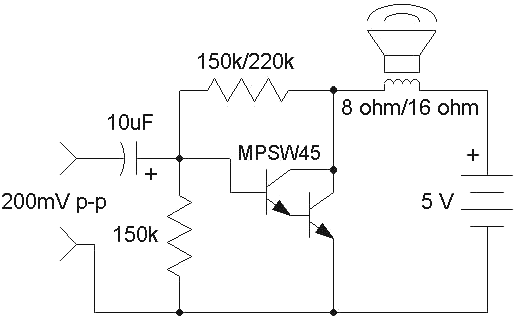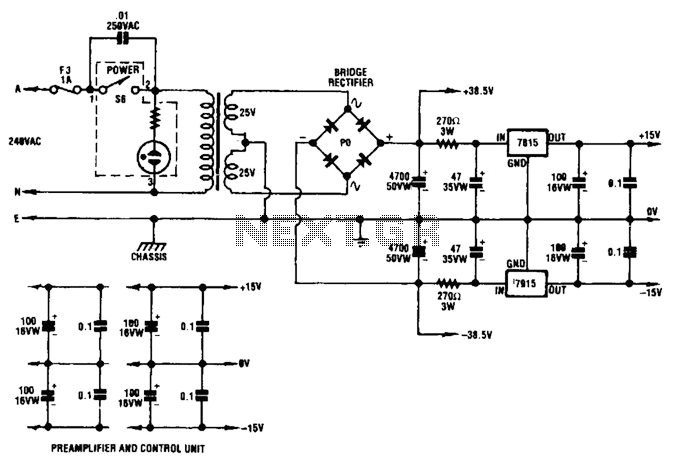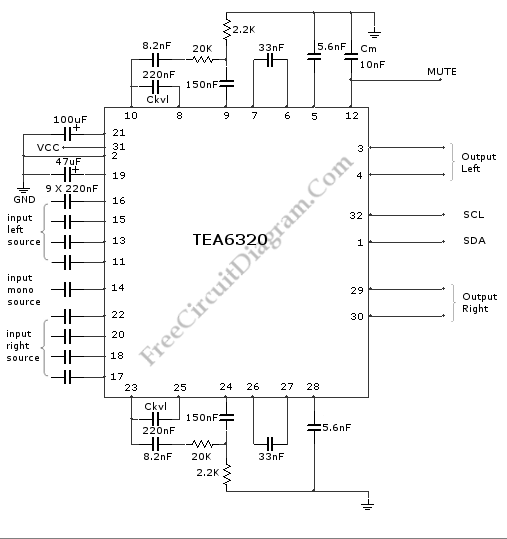
Audio Amplifiers

The first choice is usually an integrated circuit designed for the purpose. A typical assortment can be seen on this National Semiconductor page. Discrete designs can also be built with readily available transistors or op-amps, and many designs are featured in manufacturers' application notes. Older designs employed audio interstage and output transformers, but the cost and size of these parts have made them all but disappear. When the power source is a 9-volt battery, a push-pull output stage using a 500-ohm to 8-ohm transformer is more efficient than non-transformer designs when providing 100 milliwatts of audio. As a general rule, transformerless low-power speaker projects will work better with 4.5 or 6-volt battery packs of AA, C, or even D cells than 9-volt rectangular batteries. This simple amplifier shows the LM386 in a high-gain configuration (A = 200). For a maximum gain of only 20, leave out the 10 µF capacitor connected from pin 1 to pin 8. Maximum gains between 20 and 200 may be realized by adding a selected resistor in series with the same 10 µF capacitor. The 10k potentiometer will give the amplifier a variable gain from zero up to the maximum. The Curiously Low Noise Amplifier takes advantage of the excellent noise characteristics of the 2SK117 JFET, which boasts a noise voltage below 1 nV/√Hz and virtually no noise current. The noise voltage of the amplifier is only 1.4 nV/√Hz at 1 kHz, increasing to only 2.7 nV/√Hz at 10 Hz. The noise current is difficult to measure, so this simple utility amplifier can detect the noise from a 50-ohm resistor and a 100k resistor as well. The 1.4 nV input-referred noise will increase to about 1.7 nV with a 50-ohm resistor instead of a short, and a 100k resistor will yield an input-referred noise near 40 nV, with very little contribution from the amplifier. This amplifier is a "utility" amplifier with a gain of 100, typically used in a lab setting to boost tiny signals for measurement or further processing. It is not intended to drive a speaker or headphones directly, although it could drive the LM386 quite effectively. The circuit is a simple discrete transistor feedback circuit with two gain stages and a unique class-A output buffer. The 2SK117 is from the "BL" Idss current range and is selected for an Idss near 7 mA. The drain resistor is adjusted to achieve about 4 volts on the drain, and the value depends on the Idss of the JFET. Most of the resistors are not critical, but precision values are shown because the resistors should be metal film types for the best noise performance. Approximate DC voltages are shown to assist with resistor selection. Deviating from the shown voltages will reduce the available output voltage swing, but the amplifier might work fine for smaller signals. The unloaded swing should be about 6 volts peak-to-peak with about 60 mV peak-to-peak input before distortion is observed. The MPSA18 acts as a noise filter. High gain is desirable here to keep the value of the base filter capacitor reasonable, but a 2N4401 could be substituted by reducing the 10k and 120k resistors by a factor of 5. The filter will still be rolling off the noise voltage from the 15-volt supply above about 0.2 Hz. However, some power supplies can be very noisy. The feedback resistor is selected for a gain of exactly 100, and the value is well above the expected 1k, due to the limited open-loop gain of the simple circuit. A small resistor is included in series with the output for stability, and that resistor can reduce the gain a bit when driving a lower resistance load. The designer may choose to set the gain for that particular load, say 75 ohms, or for a high impedance load. The circuit can drive a lower resistance than 100 ohms, but the swing will be somewhat limited. It may be possible to leave out the 33-ohm resistor without significant impact.
This circuit design focuses on the implementation of a high-gain audio amplifier using the LM386 integrated circuit, which is optimized for low-power applications. The choice of components and configuration is critical to achieving the desired performance specifications. The LM386 is configured for a gain of 200, suitable for amplifying weak audio signals, while providing flexibility through the use of a variable gain potentiometer.
The use of the 2SK117 JFET in the Curiously Low Noise Amplifier enhances the circuit's performance by minimizing noise, which is particularly important in sensitive applications such as laboratory measurements. The design integrates a feedback mechanism to stabilize gain and ensure linear performance across varying load conditions. The choice of metal film resistors is intentional, as they offer superior noise characteristics compared to standard carbon film resistors.
The circuit's output stage includes provisions for driving low-impedance loads, with careful attention to the selection of the output resistor to maintain stability and prevent oscillations. The design also emphasizes the importance of power supply decoupling to mitigate noise, particularly when operating with potentially unstable supply voltages.
Overall, this amplifier circuit exemplifies a balance between simplicity and performance, making it suitable for a wide range of audio applications where low noise and high gain are essential. The detailed attention to component selection and circuit topology ensures that it can effectively handle the amplification of small signals while maintaining fidelity and stability.The first choice is usually an integrated circuit designed for the purpose. A typical assortment can be seen on this National Semiconductor page. Discrete designs can also be built with readily available transistors or op-amps andmany designs are featured in manufacturers` application notes. Older designs employed audio interstage and output transformers but the cost and size of these parts has made them all but disappear. (Actually, when the power source is a 9 volt battery, a push-pull output stage using a 500 ohm to 8 ohm transformer is more efficient than non-transformer designs when providing 100 milliwatts of audio. ) As a general rule, transformerless low power speaker projects will work better with 4. 5 or 6 volt battery packs of AA, C, or even D cells than 9 volt rectangulars. This simple amplifier shows the LM386 in a high-gain configuration (A = 200). For a maximum gain of only 20, leave out the 10 uF connected from pin 1 to pin 8. Maximum gains between 20 and 200 may be realized by adding a selected resistor in series with the same 10 uF capacitor.
The 10k potentiometer will give the amplifier a variable gain from zero up to the maximum. The Curiously Low Noise Amplifier takes advantage of the wonderful noise characteristics of the 2SK117 JFET that boasts a noise voltage below 1 nV/root-Hz and virtually no noise current. The noise voltage of the amplifier is only 1. 4 nV/root-Hz at 1 kHz, increasing to only 2. 7 nV/root-Hz at 10 Hz. The noise current is difficult to measure, so this simple utility amplifier can see the noise from a 50 ohm resistor and a 100k resistor, too.
(The 1. 4 nV input-referred noise will increase to about 1. 7 nV with a 50 ohm resistor, instead of a short, and a 100k resistor will give an input-referred noise near 40 nV, with very little contribution from the amplifier. ) This amplifier is a "utility" amplifier with a gain of 100, that would typically be used in a lab setting to boost tiny signals for measurement or further processing.
It isn`t intended to drive a speaker or headphones directly. (It could drive the LM386 quite nicely. ) The circuit is a simple discrete transistor feedback circuit with two gain stages and a unique class-A output buffer: The 2sk117 is from the "BL" Idss current range and is selected for an Idss near 7 mA. The drain resistor is adjusted to achieve about 4 volts on the drain and the value depends on the Idss of the JFET.
Most of the resistors aren`t critical, but precision values are shown because the resistors should be metal film types for best noise performance. Approximate DC voltages are shown for helping with resistor selection. Deviating from the shown voltages will reduce the available output voltage swing, but the amplifier might work fine for smaller signals.
Unloaded swing should be about 6 volts, p-p with about 60 mV p-p input, before distortion is observed. The MPSA18 acts as a noise filter. High gain is desirable here to keep the value of the base filter capacitor reasonable, but a 2N4401 could be substituted by reducing the 10k and 120k by a factor of 5.
The filter will still be rolling off the noise voltage from the 15 volts supply above about 0. 2 Hz. But some power supplies can be really noisy! The feedback resistor is selected for a gain of exactly 100 and the value is well above the expected 1k, due to the limited open-loop gain of the simple circuit. A small resistor is included in series with the output for stability and that resistor can reduce the gain a bit when driving a lower resistance load.
The designer may choose to set the gain for that particular load, say 75 ohms, or for a high impedance load. The circuit can drive a lower resistance than 100 ohms, but the swing will be somewhat limited. It may be possible to leave out the 33 ohm resistor without sta 🔗 External reference
This circuit design focuses on the implementation of a high-gain audio amplifier using the LM386 integrated circuit, which is optimized for low-power applications. The choice of components and configuration is critical to achieving the desired performance specifications. The LM386 is configured for a gain of 200, suitable for amplifying weak audio signals, while providing flexibility through the use of a variable gain potentiometer.
The use of the 2SK117 JFET in the Curiously Low Noise Amplifier enhances the circuit's performance by minimizing noise, which is particularly important in sensitive applications such as laboratory measurements. The design integrates a feedback mechanism to stabilize gain and ensure linear performance across varying load conditions. The choice of metal film resistors is intentional, as they offer superior noise characteristics compared to standard carbon film resistors.
The circuit's output stage includes provisions for driving low-impedance loads, with careful attention to the selection of the output resistor to maintain stability and prevent oscillations. The design also emphasizes the importance of power supply decoupling to mitigate noise, particularly when operating with potentially unstable supply voltages.
Overall, this amplifier circuit exemplifies a balance between simplicity and performance, making it suitable for a wide range of audio applications where low noise and high gain are essential. The detailed attention to component selection and circuit topology ensures that it can effectively handle the amplification of small signals while maintaining fidelity and stability.The first choice is usually an integrated circuit designed for the purpose. A typical assortment can be seen on this National Semiconductor page. Discrete designs can also be built with readily available transistors or op-amps andmany designs are featured in manufacturers` application notes. Older designs employed audio interstage and output transformers but the cost and size of these parts has made them all but disappear. (Actually, when the power source is a 9 volt battery, a push-pull output stage using a 500 ohm to 8 ohm transformer is more efficient than non-transformer designs when providing 100 milliwatts of audio. ) As a general rule, transformerless low power speaker projects will work better with 4. 5 or 6 volt battery packs of AA, C, or even D cells than 9 volt rectangulars. This simple amplifier shows the LM386 in a high-gain configuration (A = 200). For a maximum gain of only 20, leave out the 10 uF connected from pin 1 to pin 8. Maximum gains between 20 and 200 may be realized by adding a selected resistor in series with the same 10 uF capacitor.
The 10k potentiometer will give the amplifier a variable gain from zero up to the maximum. The Curiously Low Noise Amplifier takes advantage of the wonderful noise characteristics of the 2SK117 JFET that boasts a noise voltage below 1 nV/root-Hz and virtually no noise current. The noise voltage of the amplifier is only 1. 4 nV/root-Hz at 1 kHz, increasing to only 2. 7 nV/root-Hz at 10 Hz. The noise current is difficult to measure, so this simple utility amplifier can see the noise from a 50 ohm resistor and a 100k resistor, too.
(The 1. 4 nV input-referred noise will increase to about 1. 7 nV with a 50 ohm resistor, instead of a short, and a 100k resistor will give an input-referred noise near 40 nV, with very little contribution from the amplifier. ) This amplifier is a "utility" amplifier with a gain of 100, that would typically be used in a lab setting to boost tiny signals for measurement or further processing.
It isn`t intended to drive a speaker or headphones directly. (It could drive the LM386 quite nicely. ) The circuit is a simple discrete transistor feedback circuit with two gain stages and a unique class-A output buffer: The 2sk117 is from the "BL" Idss current range and is selected for an Idss near 7 mA. The drain resistor is adjusted to achieve about 4 volts on the drain and the value depends on the Idss of the JFET.
Most of the resistors aren`t critical, but precision values are shown because the resistors should be metal film types for best noise performance. Approximate DC voltages are shown for helping with resistor selection. Deviating from the shown voltages will reduce the available output voltage swing, but the amplifier might work fine for smaller signals.
Unloaded swing should be about 6 volts, p-p with about 60 mV p-p input, before distortion is observed. The MPSA18 acts as a noise filter. High gain is desirable here to keep the value of the base filter capacitor reasonable, but a 2N4401 could be substituted by reducing the 10k and 120k by a factor of 5.
The filter will still be rolling off the noise voltage from the 15 volts supply above about 0. 2 Hz. But some power supplies can be really noisy! The feedback resistor is selected for a gain of exactly 100 and the value is well above the expected 1k, due to the limited open-loop gain of the simple circuit. A small resistor is included in series with the output for stability and that resistor can reduce the gain a bit when driving a lower resistance load.
The designer may choose to set the gain for that particular load, say 75 ohms, or for a high impedance load. The circuit can drive a lower resistance than 100 ohms, but the swing will be somewhat limited. It may be possible to leave out the 33 ohm resistor without sta 🔗 External reference





